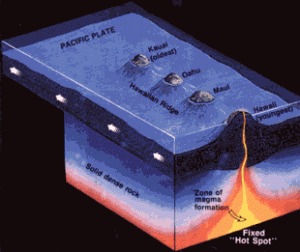Cape Verde Islands Landforms
Item
-
Title
-
Cape Verde Islands Landforms
-
Description
-
The Cape Verde Islands were formed through hotspot volcanism. This means that mantle plumes, which originated at the mantle core boundary, rise to the surface, entraining with them undepleted, or fertile mantle. As the oceanic plate moves, the hotspot will stay in the same place. This will create a chain of volcanic landforms. The chain will show the history and movement of the plate. The volcanoes created at a hotspot are shield volcanoes. Shield volcanoes can be extremely large landforms, some containing in excess of 40,000 km3 in volume (Winter, 56). Shield volcanoes are very shallow sloping, usually 3-10 degrees in slope (Winter, 56).
The largest of the Cape Verde Islands is called Fogo. This island is a large shield volcano that has been erupting for the last 20 million years (Young).
Winter, J. D. (2010). Principals of Igneous and Metamorphic Petrology. New Saddle River, NJ: Pearson Education, Inc. (pp. 5, 385-387, 455).
Image from:
Young, J. Cape Verde’s Eruption: An Example of Hotspot Volcanism. 1 Dec 2014. http://www.decodedscience.com/cape-verdes-eruption-example-hotspot-volcanism/51069
-
Creator
-
Claire Kojaian
-
Mediator
-
Tamara Carley
carleyt@lafayette.edu
-
Rights Holder
-
Lafayette College Department of Geology and Environmental Geosciences


